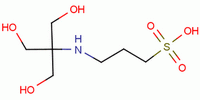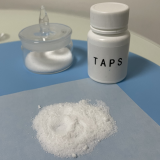- Category :
Other Chemicals/Others
- CAS NO : 29915-38-6
- EC NO : 249-954-1
- Molecular Formula : C7H17NO6S
- Main Specifications : White Powder
- Synonyms : 3-[[2-Hydroxy-1,1-bis(hydroxymethyl)ethyl]amino]-1-propanesulfonic acid; 3-[(Tris(hydroxymethyl)methyl)amino]-1-propanesulfonic acid; N-(tris(hydroxymethyl)methyl)-3-aminopropanesulfonic acid; TAPS;3-(tris(hydroxymethyl)methylamino)propane-1-sulphonic acid;N-[Tris(hydroxymethyl)methyl]-3-aminopropanesulfonic acid;3-{[1,3-dihydroxy-2-(hydroxymethyl)propan-2-yl]amino}propane-1-sulfonic acid;1-{[1,3-dihydroxy-2-(hydroxymethyl)propan-2-yl]amino}propane-1-sulfonic acid;N-[tris(hydroxymethyl)methyl]-3-amionpropanesulfonic acid;
Package: 500g/bottle
Uses : Biological buffer
Molecular Structure:

Product description:
TAPS buffer is a commonly used buffer with high solubility and stability. Its pKa value is about 8.4, allowing it to play an excellent buffering role under neutral and alkaline conditions. It can be stably stored at room temperature and has a small impact on many biomolecules, making it widely used in biochemical and molecular biology experiments.
The buffering range of TAPS buffer is usually between pH 7.7-9.1, providing stable buffering performance within the pH range. Within this range, TAPS exhibits small changes in ion strength and buffering effects, making it suitable for various experimental needs.
application area
1. Protein research: TAPS buffer is widely used in protein research, especially suitable for experiments conducted at high pH values. It can be used for protein dissolution, purification, and stability research, while having a small impact on the structure and function of proteins.
2. Enzyme activity research: Due to the stability of TAPS buffer under alkaline conditions, it is widely used in enzyme activity research. It can provide a stable reaction environment, helping researchers accurately measure enzyme activity and catalytic efficiency.
3. DNA/RNA experiments: TAPS buffer is also suitable for DNA and RNA related experiments, such as polymerase chain reaction (PCR), DNA/RNA electrophoresis, etc. It can provide a stable buffering environment, which helps maintain the stability and structural integrity of DNA/RNA
When using TAPS buffer, the following precautions should be taken:
1. TAPS buffer generates heat during the dissolution process, so caution should be exercised to avoid overheating of the solution.
2. When adjusting the pH value, a mixture of TAPS and hydrochloric acid solution can be used for adjustment, and a pH meter can be used for precise measurement.
3. It is necessary to select the appropriate concentration of TAPS buffer according to the experimental requirements and optimize it under different experimental conditions.
TAPS buffer is suitable for various experimental needs, such as protein research, enzyme activity research, and DNA/RNA experiments. When using, it is necessary to pay attention to operational precautions and select appropriate concentrations and pH values according to experimental requirements. Through reasonable application and optimization, researchers can obtain accurate and reliable experimental results.
 CN ChemNet > Gold Suppliers > Hubei new DE sheng material science and technology co., LTD. >
CN ChemNet > Gold Suppliers > Hubei new DE sheng material science and technology co., LTD. > 